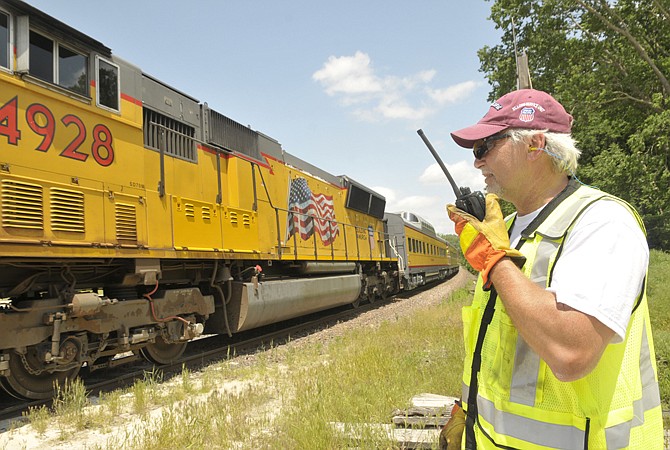Railroad people say it all the time - and hope that saying it often will get the message across to everyone: That big, heavy train heading for the crossing can NOT "stop on a dime."
When an engineer or conductor sees a vehicle on the tracks, they immediately can pull a couple of levers that activate all the train's brakes.
"When you're moving at 50 miles an hour, it's going to take you a long ways to get stopped," Supervisor Glenn Davis told reporters Thursday afternoon.
"At that point, the crew is just praying that the car will get off the tracks - because there's nothing they can do about hitting it."
Union Pacific engineer Steve Yerby, a third-generation railroad worker from Bland, said he's never had an accident at a grade crossing.
"But the near-misses - they make me think really hard, and they can get your heart pumping," he explained. "We're on a set pattern here (going down the tracks).
"We don't have a steering wheel. We can't swerve to miss them."
It's really a simple matter of physics, experts say.
"Loaded coal trains are usually about 15,000 to 20,000 tons," Davis noted.
That's up to 40 million pounds.
"Some trains out here are 14 thousand feet long (2.65 miles) and weigh 21,000 tons (42 million pounds)," he added. "It takes a long time to get those stopped."
The comments came during a special trip Thursday afternoon for elected and other government officials, and some media representatives, about crossing and pedestrian safety.
The round trip ran from just west of the Capitol to just east of the Osage River, where a second railroad bridge is under-construction. It was the first of several special excursions that Union Pacific has scheduled for Missouri and Illinois.
Cole County Public Works Director Larry Benz was one of the officials taking Thursday's ride.
He said it was good to see some of the crossings from the train crew's perspective - although the crossings upgrades and maintenance mostly are the railroad's and state Transportation department's work.
"I'm not sure that we've got any crossings left that aren't signaled now," Benz said. "We've been able to get lights at most of our crossings."
Before that, Benz said, there was more likelihood of danger.
"You're always going to have that one person who thinks the lights aren't for him, and they'll try and go around (the gates) and they'll have an accident," he said. "We've had some fatality accidents, like at Old Stage Road - but since the lights went in, we haven't had any incidents."
The special trips come as Union Pacific Railroad has launched a new grants program for community railroad safety initiatives.
Mark Davis, a UP spokesman based in Omaha, noted the railroad industry has been trying to improve passenger and rail safety for more than a century.
Union Pacific launched "Operation Lifesaver" in 1972, and has seen the program expand throughout the industry, the country and the world.
"We found - what we've heard over the last several years from communities," Davis explained, "is that they need financial resources, to help further get the message out."
Using money already designated for grade-crossing safety programs, UP will award from $500 to $5,000 for communities to have an opportunity to develop new ideas to promote safety, he said.
Two things pedestrians should remember, he added: People shouldn't walk along the tracks as a shortcut, and never use a railroad bridge to cross water, or as a fishing pier.


